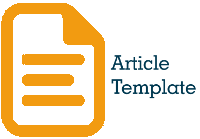DECISION SUPPORT SYSTEM FOR EMPLOYEE PERFORMANCE ASSESSMENT ON KANDATEL BONE SAW METHOD
DOI:
https://doi.org/10.35457/antivirus.v15i1.1358Keywords:
Sistem Pendukung Keputusan, SAW, Karyawan, Penilaian, PHPAbstract
: An employee is a person who provides services both in the form of thoughts and energy and gets compensation that has been determined by a company or an organization. In Kandatel Bone itself, the employee assessment process is still done simply by evaluating employee attendance and assessing the weekly reports of each employee so that it is still difficult in grouping data and takes a long time in validating data and potentially producing inaccurate output, and it can at any time harm employees and the company itself. So to solve the problem, a Decision Support System is needed to assess the performance of Kandatel Bone employees. Decision Support System is an interactive information system that provides information, modeling, and data manipulation commonly used for decision making in semi-structured and unstructured situations, so no one knows exactly how the decision was made. The research method used in this research is Simple Additive Weighting (SAW) method. SAW method is a method commonly known as weighted summing method by calculating the value of each alternative of the criteria, then normalizing the decision matrix, doing the sorting and determining the best employees. And design a system to be built web-based using the PHP programming language. In this study, the final questionnaire was conducted to find out user acceptance, from 23 respondents obtained the results of 89.67% of user acceptance rate. So that the results of this study showed that a Support System for Employee Performance Assessment Decisions in Kandatel Bone can be received very well by users.
Downloads
References
Handayani, R. I. “Sistem Pendukung Keputusan Pemilihan Karyawan Berprestasi Dengan Metode Profile Matching Pada PT. Sarana Inti Persada (SIP),” Jurnal Pilar Nusa Mandiri, vol.13, no.1, pp. 28-34, 2017
Hamzah, Suyoto, and Paulus Mudjihartono. “Sistem Pendukung Keputusan Penilaian Kinerja Dosen Dengan Metode Balanced Scorecard (Studi Kasus: Universitas Respati Yogyakarta),” Seminar Nasional Informatika (SEMNASIF), vol.1, no.5, 2015
Wahyudi, Nopri, “Sistem Informasi Monitoring Penilaian Kinerja Karyawan Dalam Perkembangan Proyek Menggunakan Metode Smart,” Skripsi Tesis, Jurusan Sistem Informasi Fakultas Sains dan Teknologi, Universitas Islam Negeri Sultan Syarif Kasim Riau, Riau, Indonesia, 2020
Farkhan Hariyadi, Citra Wiguna, Rizky Firdaus, Jihan Shinta, and Oka Dwi, “Desain Sistem Pendukung Keputusan Untuk Penentuan Karyawan Terbaik Menggunakan Metode Analytic Network Process (Studi Kasus: IT Telkom Purwokerto),” Conference on Electrical Engineering, Telematics, Industrial technology, and Creative Media (CENTIVE), vol.2 no.1, 2019
Saputra, Prasetya Adhytiatama, and Hendra Gunawan. “Sistem Pendukung Keputusan Penilaian Kinerja Helpdest Data Management di PT.Telkom Witel Bandung Menggunakan Metode TOPSIS.” Jurnal Accounting Information System (AIMS), vol.3, no.2, pp.96-105, 2020
Antika, Ririn, and Tri Susilowati. “Sistem Pendukung Keputusan Penilaian Kinerja Karyawan Pada SMAN 1 Sukoharjo Menggunakan Metode SAW (Simple Additive Weighting),” Prociding KMSI, vol.5, no.1, 2017
Frieyadie. “Penerapan Metode Simple Additive Weight (SAW) Dalam Sistem Pendukung Keputusan Promosi Kenaikan Jabatan,” Jurnal Pilar Nusa Mandiri, vol.12, no.1, pp.37-45, 2016.
Ekkal Prasetyo. “Rancang Bangun Sistem Informasi Sekolah Tinggi Ilmu Ekonomi Rahmansyah Kabupaten Musi Banyuasin Berbasis Website,” Jurnal Informanika, vo.1, no.2, pp.19-30, 2015
Rakasiwi, Sundhu, and Sri Wahyuning. “Pengembangan Sistem Informasi Penentuan Prestasi Karyawan Telkom DIVRE IV Berbasis DSS Dengan Menggunakan Metode AHP,” ELKOM: Jurnal Elektronika dan Komputer, vol.7, no.2, 2014
Pratomo, Adi, and Agus Irawan, “Pengembangan Media Pembelajaran Interaktif Berbasis Web Menggunakan Metode Hannafin dan Peck,” Jurnal Positif, vol.1 no.1, pp.14-28. 2015
Downloads
Published
Issue
Section
License
Authors who publish with this journal agree to the following terms:
- Copyright on any article is retained by the author(s).
- Author grant the journal, right of first publication with the work simultaneously licensed under a Creative Commons Attribution License that allows others to share the work with an acknowledgement of the work’s authorship and initial publication in this journal.
- Authors are able to enter into separate, additional contractual arrangements for the non-exclusive distribution of the journal’s published version of the work (e.g., post it to an institutional repository or publish it in a book), with an acknowledgement of its initial publication in this journal.
- Authors are permitted and encouraged to post their work online (e.g., in institutional repositories or on their website) prior to and during the submission process, as it can lead to productive exchanges, as well as earlier and greater citation of published work.
- The article and any associated published material is distributed under the Creative Commons Attribution-ShareAlike 4.0 International License











